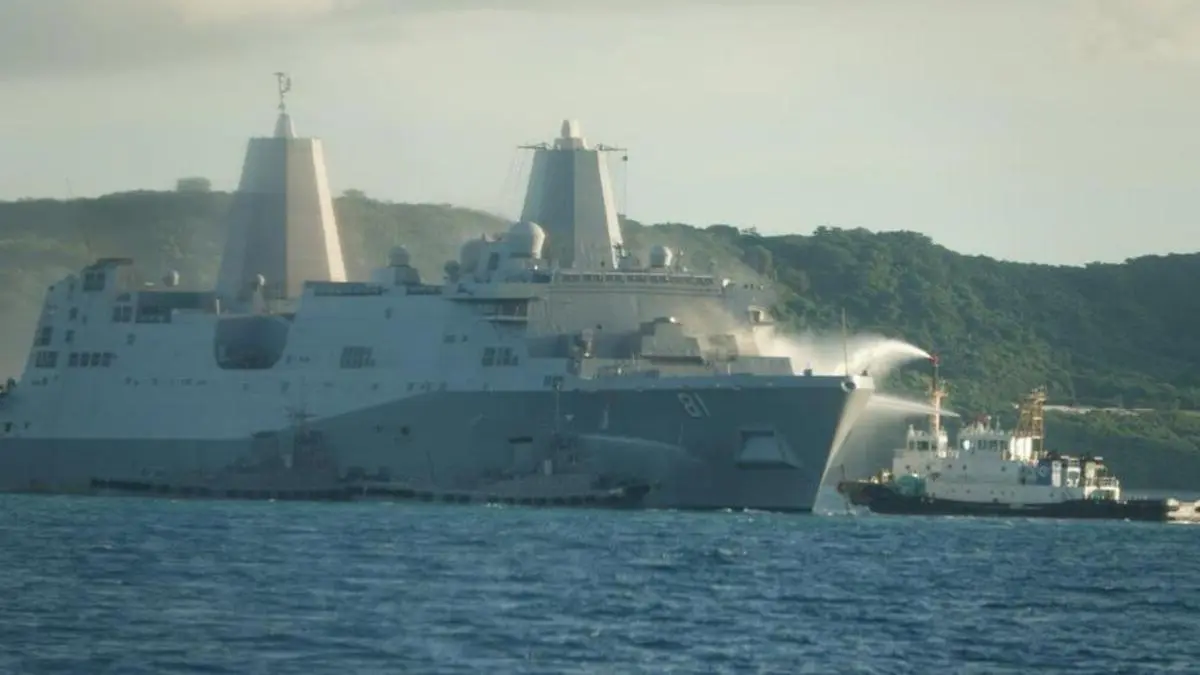“(Naha, Okinawa – August 20, 2025)
What we know
- The fire was reported at 5:00 p.m. local time* while the New Orleans was operating at White Beach in Uruma City, Okinawa. Japanese broadcaster NHK footage showed tugboats directing water jets at the ship’s bow as smoke billowed from the forward section.
- The US 7th Fleet acknowledged the incident, saying: “Cruises are working to contain a fire that broke out on USS New Orleans (LPD-18) this evening, August 20 (Japan time) (Japan time) near Okinawa, Japan.”
- As of press time, no injuries or oil spills had been reported by Japanese officials; Japan Coast Guard (JCG) and The ship joined the effort after a JSDF request for assistance.
Response at Sea
Statements and images from the Japanese Coast Guard show a maritime firefighting situation. Two tugs and at least one JSDF ship are assisting. Japanese units established a perimeter and supported water-based suppression while U.S. Navy crews remained on board to conduct damage control. According to reports from Okinawa, the firefighting request was initiated, paused and re-established, consistent with on-scene commanders balancing ventilation, compartment access and external water use on the modern amphibious hull.
Separately, a U.S. official told defense outlets that the fire is under control, though complete extinguishing and post-fire inspections are still pending — a critical task for safety and engineering teams before re-energizing the affected areas. The difference.
USS New Orleans About (LPD-18)
USS New Orleans is a San Antonio-class amphibious transport dock designed to launch Marines, landing craft, and aircraft for expeditionary operations. Forward-deployed in Sasebo with the 7th Fleet, the ship supports Indo-Pacific amphibious readiness, humanitarian assistance, and theater-security missions. Key features include a well deck for LCAC/LCU operations and a flight deck capable of handling rotary-wing and tilt-rotor aircraft such as the MV-22 Osprey.
What’s not yet known
Investigators will first look at the origin and spread – specifically smoke emanating from the forward/bow area – along with any work packages, hot-work permits, or location-related material status. Officials have called the Western Pacific The amphibious schedule did not release details on the cause, extent of damage, or operational impact. Expect an initial safety message followed by a formal injury or physical injury inquiry once it is safe to enter the areas.
Why it matters
Even brief disruptions to forward-based LPDs can strain amphibious lift capacity for exercises, contingency response, and logistics support in the first and second island chains. While the Navy and industry have improved post-incident recovery efforts after previous high-profile shipboard fires, the timeline from control to certification will depend on how deeply the fire has affected structural members, cabling trunks, and mission systems. For now, officials emphasize that personnel safety and environmental protection criteria have been met, with no injuries or oil spills. No discharges reported No.
Official Line, So Far
“The crew is responding to a fire on USS New Orleans (LPD-18) this evening off Okinawa, Japan. “We will provide more details as they become available.” — U.S. 7th Fleet
What to Watch Next
- Damage Assessment: Engineering and NAVSEA teams will determine if repairs can be made in theater or require a more extensive availability.
- Operational Rerouting: If New Orleans requires pier-side time beyond its routine inspection, 7th Fleet and III MEF may reassign the lift or adjust the exercise timeline.
- Safety Bulletin: Expect interim guidance on Fire Detection/Suppression Readiness Checks on San Antonio-class as the investigation progresses.”
Read More: Thales Unveils Compact Airborne AESA Concept Aimed at Light Combat Aircraft Market
FAQs
The USS New Orleans (LPD-18) caught fire while docked near White Beach in Uruma City, Okinawa. Tugboats and Japanese Coast Guard vessels assisted the U.S. crew in extinguishing the fire. Fortunately, there were no reports of injuries or oil spills, and the crew worked quickly to control the situation.
U.S. Navy crews and Japanese units are using tugs and other vessels in the firefighting effort. Water jets are being directed at the ship, while crews are inspecting the ship’s interior for smoke and damage. The fire is reportedly under control, but inspections are ongoing to ensure safety.
Yes. The USS New Orleans supports amphibious operations, including Marines, landing craft and aircraft. Any disruption could impact exercises, logistics or contingency plans in the First and Second Island Chains. Officials are investigating whether repairs can be made locally or whether the ship requires more extensive maintenance.
Fires on board ships are rare but serious, highlighting the importance of fire detection systems and rapid damage control. The incident also demonstrates how U.S. and Japanese forces collaborate in the Indo-Pacific, ensuring safety and readiness. Trends in naval technology are focused on improving fire suppression, crew safety, and emergency response for modern amphibious ships.








Leave a Reply